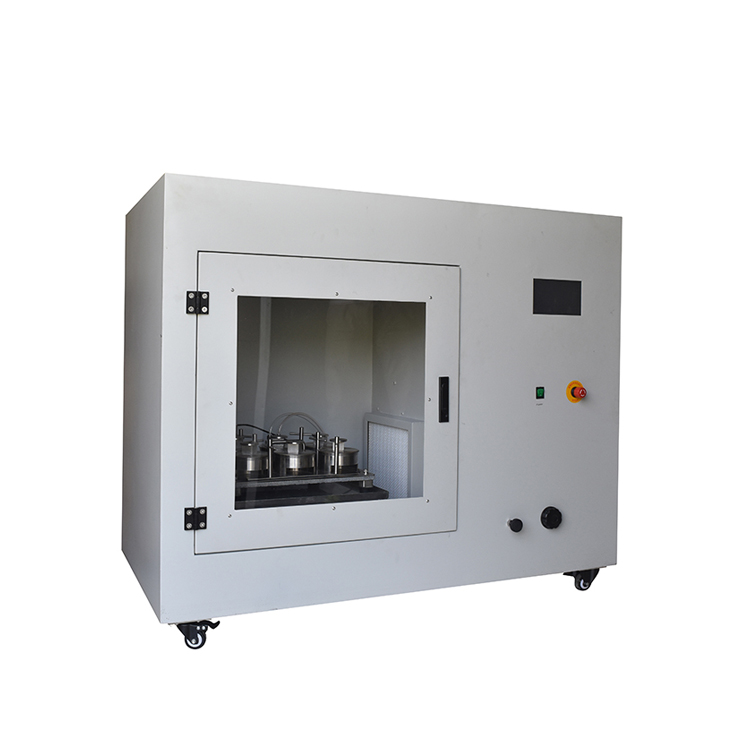What is a Dry microbial penetration resistance tester?
Numerous examples demonstrate that bacteria can penetrate shielding materials along with dry organic or inorganic particles, such as bacteria-carrying dander or cleanroom clothing, or even packaging materials during storage. This instrument can be used to measure a material's resistance to bacterial penetration by dry particles within the size range of human dander. In applications such as medical protection, food processing, and cleanrooms, the penetration risk of dry microorganisms (such as bacterial and fungal spores in dry environments) is often overlooked. However, resistance to dry microbial penetration is directly related to the integrity of product protection. The STD Dry Microbial Penetration Resistance Tester is designed based on the suspension and diffusion characteristics of dry microorganisms. Through precise parameter control, full standard compliance, and scientific testing principles, it provides dry microbial protection testing solutions for multiple industries, filling the gap in dry-phase testing.
I. Principle of the Dry Microbial Penetration Resistance Tester
The Dry Microbial Penetration Resistance Tester evaluates a material's resistance to microbial penetration by simulating the actual microbial contact between the material and the material in a real-world environment. This instrument utilizes a unique dry-state testing technology, cultivating microorganisms in a dry environment and applying a certain amount of pressure or suction to simulate the penetration behavior of microorganisms in real environments. By observing the attachment, growth, and penetration of microorganisms on a material surface, the material's resistance to microbial penetration can be accurately assessed.
II. Applications of Dry-State Microbial Penetration Resistance Testers
Dry-state microbial penetration resistance testers have a wide range of applications in various
fields. In the medical field, they can be used to evaluate the microbial penetration resistance of materials such as medical dressings and surgical instruments, ensuring the hygienic safety of medical equipment and supplies. In the public health field, they can be used to evaluate the protective effectiveness of personal protective equipment such as protective clothing and masks, providing strong support for epidemic prevention and control. In the food safety field, they can be used to evaluate the microbial penetration resistance of food packaging materials to ensure food quality and safety.
III. Operating the Dry Microbial Penetration Resistance Tester
The operating procedures for the dry microbial penetration resistance tester are relatively simple, but require strict adherence to the operating procedures. First, prepare the material to be tested and the microbial culture. Then, evenly apply the microbial culture to the surface of the material and place it in the tester. Next, set the test parameters, such as pressure, temperature, and time, according to the test requirements. Finally, start the tester, wait for the test to complete, and then observe and record the test results.
Test Steps Explanation
This test is conducted on specimens fixed to separate containers. Six containers are prepared, five of which contain talc powder contaminated with Bacillus subtilis as the test group, and one contains uncontaminated talc powder as the control. A petri dish is inserted into the bottom of each container, near the bottom of the specimen. The container is supported by a gas ball oscillator, which causes the talc powder that penetrates the specimen to fall into the petri dish. The petri dish is then removed for incubation, and the number of colonies grown is counted.
Equipment Commissioning
Ensure the Dry Microbial Penetration Resistance Tester operates properly:
Leveling: Using a spirit level, adjust the four rubber supports to ensure the instrument is level.
Adjusting the Frequency of the Gas Ball Oscillator: Set the gas ball oscillator to a frequency of 20.800 vibrations per minute.
Sample Preparation
Cutting Specimens: Cut 12 test specimens measuring 200 mm x 200 mm.
Sterilization: Sterilize the cut specimens and test containers.
Securing the Test Container: Secure the test container to the mounting plate using a rubber ring, ensuring a tight connection between the container and the mounting plate, with the bottom resting against the stone slab.
Prepare talc: Prepare talc containing AATCC 9372 Bacillus subtilis spores at a concentration of approximately 10⁸ CFU/g. The preparation process is described in YY/T 5056.5-2009.
Start the experiment
Using aseptic techniques, remove the specimen and place it on the top of each test container.
Push down the plunger, secure the lid to the container, and secure the specimen with a controlled degree of looseness. Then remove the plunger.
Add 0.5g ± 0.1g of contaminated talc to the specimen through the plunger opening. Add uncontaminated talc to the sixth container as a control. Seal the plunger opening with adhesive tape.
Place a small plastic bag over each container.
Insert an uncovered petri dish through the narrow opening at the bottom of each container and seal the narrow opening with adhesive tape.
Vibrate the container at a frequency of 20.800 vibrations per minute for 30 minutes.
After vibration, remove the plastic bag and adhesive tape.
Insert the lid of the Petri dish through the narrow opening, remove the dish, and incubate at 35°C for 24 hours.
Count the colonies formed on the dish. A valid sample requires a reading of 0 on the control dish. Otherwise, it indicates external contamination and the test should be terminated.
Repeat the above experimental steps for at least two more sets of tests. Calculate the arithmetic mean of 10 valid results as the final result.
Test End
After the test, confirm that the data has been recorded. Adjust the pressure regulator knob on the control panel to 0. turn off the instrument's air intake, turn on the exhaust fan and lighting, and clean the surfaces of each sample box.
During the test, please note the following points:
First, ensure the cleanliness of the test environment to avoid interference from external microorganisms; second, strictly follow the operating procedures and parameter settings to ensure the accuracy of the test results; third, pay attention to personal safety and avoid direct contact with the microbial cultures.
Maintenance Guide
Keep the Instrument Dry
To ensure proper operation and extend its lifespan, keep the instrument dry and operate in a relatively dry environment. Avoid splashing water or condensation to prevent damage to non-water-resistant components. If the instrument is not in use for an extended period, disconnect the power supply and cut off the air supply.
Component Replacement
The internal starting oscillator is a fragile component. When it reaches the end of its service life, the oscillation frequency accuracy will decrease. It is recommended to replace it with a new component. Additionally, if the marble slab is damaged, replace it with a component of the same specification immediately.
Microbiological Safety Protection
To prevent contamination of test personnel and the testing environment, test personnel should have a basic understanding of microbial culture and strictly adhere to laboratory operating procedures.
Future Development
With the continuous advancement of technology and the growing awareness of microbiological safety issues, the application prospects of the dry-state microbial penetration tester will expand. In the future, the instrument will become more intelligent, automated, and precise, improving testing efficiency and accuracy. Furthermore, with the continuous emergence of new materials and the deepening of microbiological research, the instrument will be applicable in more fields and scenarios, providing stronger protection for people's health and safety. Furthermore, the Dry Microbial Penetration Tester will be integrated with advanced technologies such as big data and artificial intelligence to enable data sharing, remote monitoring, and intelligent analysis. This will contribute to the establishment of a global microbial safety monitoring and early warning system, enhancing global public health safety.
In summary, the Dry Microbial Penetration Tester, with its unique principle, wide range of applications, standardized operating procedures, meticulous maintenance requirements, and promising development prospects, plays an indispensable role in ensuring microbial safety. We believe that with continued technological innovation, it will shine in even more fields in the future, creating a safer and healthier living and working environment for humanity and becoming a solid line of defense for public health safety.


